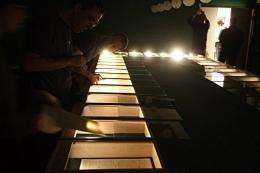Einstein's theory of relativity on display for first time

In a darkened room in Jerusalem, the world was given a rare glimpse Sunday into the mind of Albert Einstein as he worked to unlock the secrets of the universe.
The display of 46 pages, each handwritten by the famed scientist, marks the first time the complete, original manuscript of his landmark "General Theory of Relativity" has been presented in public.
The exhibit, which opened on Sunday night, forms part of the 50th anniversary celebrations of the Israeli Academy of Sciences and Humanities and coincides with Einstein's birthday on March 14.
Like a shrine to science, the pages form a rectangle in the centre of an otherwise barren room, each one encapsulated in its own pine casing and illuminated by the faintest of light, to preserve the fragile paper.
"It speaks for itself and it is exhibited like a work of art," said curator Hanoch Gutfreund, struggling to contain the emotion evoked by the work.
Page after page is filled with Einstein's spidery handwriting and the mathematical formulas. Parts are underlined, others crossed out and rewritten as he strove to perfect what Gutfreund called his "most important intellectual achievement."
"One can almost look over Einstein's shoulder while he was at work," he said. "The comments that are added to numerous pages shed light on Einstein's basic ideas, the challenges he faced and the difficulties he encountered."
Written in Einstein's home in Berlin in 1916 and donated to Jerusalem's Hebrew University during its inauguration in 1925, the document redefined mankind's understanding of the fabric of our existence -- space, time and gravity.
"It is the basis of our understanding of the universe, it is the basis of modern research in cosmology, the structure of the universe and the expansion of the universe," Gutfreund told AFP.
To preserve the document and prevent the paper and ink from decaying, the pages have been displayed in a specially darkened room, with carefully controlled humidity and temperature, said Timna Elper, head of the laboratory for preserving and restoring documents at the National Library of Israel.
"This is the first time we are displaying the whole thing. Some pages have been displayed in the past but not the whole document," she said as she monitored the exhibit on a computer screen, the picture filmed with special night-vision cameras.
Curators would only agree to a three-week display of the priceless document, which was transported to the academy in an armoured truck from its repository at the national library.
The work revolutionised scientists' understanding of the universe and underpinned a century of major discoveries by theorising, among other things, that the flow of time was affected by the force of gravity.
Clocks will run faster the further they are from a large gravitational source and run slower when closer.
This has practical applications that allowed the development of space-age technologies, including the ability to track the exact paths of satellites and determine our own locations through Global Positioning Systems (GPS).
Gutfreund said the display also served to highlight "the connection between Albert Einstein and the Hebrew University and the Jewish people."
Einstein, who was born in 1879 and won the Nobel Prize for physics in 1921 before fleeing Nazi Germany for the US in the 1930s, helped to establish the university during the early days of the British-ruled Palestine mandate.
He later declined an offer to become Israel's president in 1952 but willed all of his papers to the Hebrew University, before his death in 1955 in the United States.
The exhibition runs until March 25.
(c) 2010 AFP

















